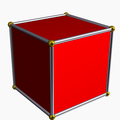Hexahedron
polyhedron with six faces From Wikipedia, the free encyclopedia
Remove ads
A hexahedron (plural: hexahedra) is any polyhedron with six faces. A cube, for example, is a regular hexahedron with all its faces square, and three squares around each vertex.
There are seven topologically distinct convex hexahedra,[1] one of which exists in two mirror image forms. (Two polyhedra are "topologically distinct" if they have intrinsically different arrangements of faces and vertices, such that it is impossible to distort one into the other simply by changing the lengths of edges or the angles between edges or faces.)
There are three further topologically distinct hexahedra that can only be realised as concave figures:
Remove ads
Related pages
- Prismatoid
References
Other websites
Wikiwand - on
Seamless Wikipedia browsing. On steroids.
Remove ads
















